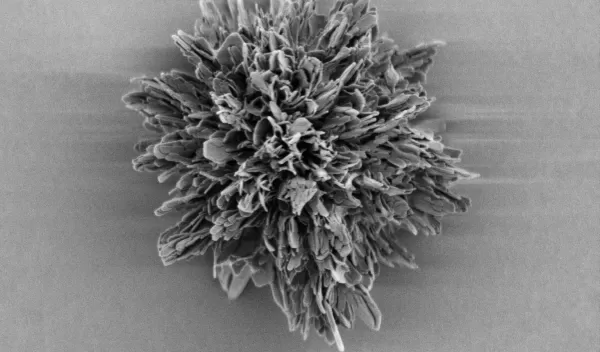
World's most complex microparticle: A synthetic that outdoes nature's intricacy
Synthetic microparticles more intricate than some of the most complicated ones found in nature have been produced by a University of Michigan-led international team. The researchers also investigated how that intricacy arises and devised a way to measure it.
The National Science Foundation-funded research paves the way for more stable fluid-and-particle mixes, such as paints, and new ways to twist light -- a prerequisite for holographic projectors. The results were published in the journal Science.
The particles are composed of twisted spikes arranged into a ball a few microns, or thousandths of a millimeter, across.
Biology is a great creator of complexity on the nano- and micro-scales, with structures such as plant pollen, immune cells and some viruses. Among the most complex natural particles on the scale of the new synthetic particles are spiky coccolithophores.
A few microns in diameter, these algae are known for building intricate limestone shells. To better understand the rules that govern how particles like these grow, scientists and engineers try to make them in the lab. Until now, there was no formalized way to measure the complexity of the results.
"Numbers rule the world and being able to rigorously describe spiky shapes and put a number on complexity enables us to use new tools like artificial intelligence and machine learning in designing nanoparticles," said Nicholas Kotov, who led the project.
From the results of the experiments and simulations, it appears that UV energy was absorbed into the particles and transformed through quantum mechanical interactions, becoming circularly polarized visible light by the time it left through the curved spikes.
The researchers believe that the tactics they uncovered can help scientists engineer particles that improve biosensors, electronics and the efficiency of chemical reactions.
"Producing these synthetic microparticles in large quantities and with high quality requires scalable nanomanufacturing approaches such as the one studied here," said Khershed Cooper, a program director in NSF's Division of Civil, Mechanical and Manufacturing Innovation.
Added Randy Duran, a program director in NSF's Division of Materials Research, "NSF's strategic investment in cutting-edge instrumentation at universities combined with new AI methodologies has taken the science of biomaterials to a new level."


